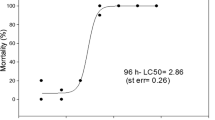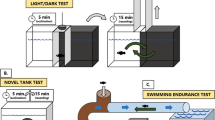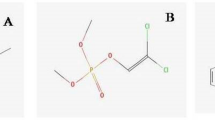Abstract
In this study the effects of 3,4-dichloroaniline (3,4-DCA), a decomposition product of the herbicides propanil and diuron (and other pesticides), and diazinon, a neurotoxic insecticide, on early life stages of zebrafish Danio rerio were assessed. The toxicity of these substances with different modes of action (acetylcholine esterase inhibitor vs. polar narcosis) was tested for single substances as well as in binary mixtures. To study effects on different biological organisation levels (from the molecular up to the whole organism level) the molecular stress response regarding Hsp70, the embryonic and larval development and the locomotor activity were investigated as integrative biomarkers. In single substance tests 3,4-dichloroaniline elicited deformations at ≥0.25 mg/l during the 11 days subchronic test, whereas locomotor activity and mortality were impaired at ≥0.5 mg/l. Diazinon effects on those parameters were obvious at ≥2 mg/l, except for the deformation rate (11 days:1 mg/l). In equitoxic mixtures of both substances concentration additivity was observed for deformation rate and mortality (11 days). An increase in the Hsp70 content occurred in zebrafish exposed to 0.25 mg 3,4-DCA/l as well as to 0.05 mg diazinon/l; in mixtures concentration additivity could be shown. The investigated endpoints varied in respect to their sensitivity, with deformations and Hsp70 levels as most sensitive parameters concerning 3,4-DCA and Hsp70 as most sensitive parameter concerning diazinon. Accordingly, for an integrated understanding of the effects of chemicals and their mixtures on fish, a battery of different test methods should be applied.









Similar content being viewed by others
References
Allner B (1997) Toxikokinetik von 3,4-Dichloranilin beim dreistacheligen Stichling (Gasterosteus aculeatus) unter besonderer Berücksichtigung der Fortpflanzungsphysiologie. Dissertation, Johann Gutenberg-Universität, Mainz
Altenburger R, Walter H, Grote M (2004) What contributes to the combined effect of a complex mixture? Environ Sci Technol 38:6353–6362. doi:10.1021/es049528k
Ansari BA, Aslam M, Kumar K (1987) Diazinon toxicity: activities of acetylcholinesterase and phosphatases in the nervous tissue of zebra fish, Brachydanio rerio (Cyprinidae). Acta Hydrochim Hydrobiol 15:301–306. doi:10.1002/aheh.19870150309
Arnold LM, Lin DT, Schultz TW (1990) QSAR for methyl- and/or chloro-substituted anilines and the polar narcosis mechanism of toxicity. Chemosphere 21:183–191. doi:10.1016/0045-6535(90)90390-F
Aydin R, Köprücü K (2005) Acute toxicity of diazinon on the common carp (Cyprinus carpio L.) embryos and larvae. Pestic Biochem Physiol 82:220–225. doi:10.1016/j.pestbp.2005.03.001
Bachmann J (2002) Entwicklung und Erprobung eines Teratogenitäts-Screening Testes mit Embryonen des Zebrabärblings Danio rerio. Dissertation, Technische Universität Dresden, Dresden
Bailey HC, Miller JL, Miller MJ, Wiborg LC, Deanovic L, Shed T (1997) Joint acute toxicity of diazinon and chlorpyrifos to Ceriodaphnia dubia. Environ Toxicol Chem 16:2304–2308. doi:10.1897/1551-5028(1997)016<;2304:JATODA>;2.3.CO;2
Bailey HC, Deanovic L, Reyes E, Kimball T, Larson K, Cortright K, Connor V, Hinton DE (2000) Diazinon and chlorpyrifos in urban waterways in Northern California, USA. Environ Toxicol Chem 19:82–87. doi:10.1897/1551-5028(2000)019<;0082:DACIUW>;2.3.CO;2
Becker B, Görge G, Kalsch W, Zock A (1990) Aufnahme, Metabolismus, Elimination, und Toxizität von aromatischen Aminen bei Zebrabärblingen. UBA-Forschungsvorhaben 106 03 053/02
Bradford MM (1976) A rapid and sensitive method for the quantification of microgram quantities of protein using the principle of protein-dye binding. Anal Biochem 72:248–254. doi:10.1016/0003-2697(76)90527-3
BUA (1994) 2, 4-Dichloranilin, 2, 5-dichloranilin, 3, 4-dichloranilin Wissenschaftliche Verlagsgesellschaft S. Hirzel Verlag, Stuttgart
Chon T-S, Chung N, Kwak I-S, Kim J-S, Koh S-C, Lee S-K, Leem J-B, Cha EY (2005) Movement behaviour of medaka (Oryzias latipes) in response to sublethal treatments of diazinon and cholinesterase activity in semi-natural conditions. Environ Monit Assess 101:1–21
Escher BI, Hermens JLM (2002) Modes of action in ecotoxicology: their role in body burdens, species sensitivity, QSARs, and mixture effects. Environ Sci Technol 36:4201–4217. doi:10.1021/es015848h
EU (2006) European Union Risk Assessment Report 65: 3,4-dichloroaniline
Gerhardt A (2000) A new Multispecies Freshwater Biomonitor for ecologically relevant surveillance of surface waters. In: Butterworth FM, Gunatilaka A, Gonsebatt ME (eds) Biomonitors and biomarkers as indicators of environmental change, vol II. Kluwer-Plenum Press, New York, pp 301–317
Gerhardt A, Svensson E, Clostermann M, Fridlund B (1994) Monitoring of behavioral patterns of aquatic organisms with an impedance conversion technique. Environ Int 20:209–219. doi:10.1016/0160-4120(94)90138-4
Hallare AV, Köhler H-R, Triebskorn R (2004) Developmental toxicity and stress protein responses in zebrafish embryos after exposure to diclofenac and its solvent, DMSO. Chemosphere 56:659–666. doi:10.1016/j.chemosphere.2004.04.007
Hertl J, Nagel R (1993) Bioconcentration and metabolism of 3, 4-dichloroaniline in different life stages of guppy and zebrafish. Chemosphere 27:2225–2234. doi:10.1016/0045-6535(93)90134-Q
Hoang TC, Tomasso JR, Klaine SJ (2004) Influence of water quality and age on nickel toxicity to fathead minnows (Pimephales promelas). Environ Toxicol Chem 23:86–92. doi:10.1897/03-11
Hodson PV (1985) A comparison of the acute toxicity of chemicals to fish, rats and mice. J Appl Toxicol 5:220–226. doi:10.1002/jat.2550050403
Jonker MJ, Svendsen C, Bedaux JJM, Bongers M, Kammenga JE (2005) Significance testing of synergistic/antagonistic, dose level-dependent, or dose ratio-dependent effects in mixture dose–response analysis. Environ Toxicol Chem 24:2701–2713. doi:10.1897/04-431R.1
Kamrin MA (1997) Pesticide profiles toxicity, environmental impact and fate. Lewis Publishers, Boca Raton, New York
Keizer J, D’Agostino G, Vittozzi L (1991) The importance of biotransformation in the toxicity of xenobiotics to fish I toxicity and bioaccumulation of diazinon in guppy (Poecilia reticulata) and zebra fish (Brachydanio rerio). Aquat Toxicol 21:239–254. doi:10.1016/0166-445X(91)90075-K
Kienle C, Köhler H-R, Filser J, Gerhardt A (2008a) Effects of nickel chloride and oxygen depletion on behaviour and vitality of zebrafish (Danio rerio, Hamilton, 1822) (pisces, cypriniformes) embryos and larvae. Environ Pollut 153:612–620. doi:10.1016/j.envpol.2007.06.069
Kienle C, Köhler H-R, Gerhardt A (2008b) Behavioural and developmental toxicity of chlorpyrifos and nickel chloride to zebrafish (Danio rerio) embryos and larvae. Ecotoxicol Environ Saf (submitted)
Kimmel CB (1989) Genetics and early development of zebrafish. Trends Genet 5:283–288. doi:10.1016/0168-9525(89)90103-0
Köhler H-R, Alberti G, Seniczak S, Seniczak A (2005) Lead-induced Hsp70 and Hsp60 pattern transormation and leg malformationduring postembryonic development in the oribatid mite, Archegozetes longisetosus Aoki. Comp Biochem Phys C 141:398–405
Meier EP, Dennis WH, Rosencrance AB, Randall WF, Cooper WJ, Warner MC (1979) Sulfotepp, a toxic impurity in formulations of diazinon. Bull Environ Contam Toxicol 23:158–164. doi:10.1007/BF01769935
Nagel R (2002) DarT: the embryo test with the zebrafish Danio rerio—a general model in ecotoxicology and toxicology. Altern Anim Exp—ALTEX 19:38–48
Nüsslein-Volhard C (1994) Of flies and fishes. Science 266:572–574. doi:10.1126/science.7939708
OECD (1992) OECD Guideline for testing of chemicals 203: fish, acute toxicity test
Osterauer R, Köhler H-R (2008) Temperature-dependent effects of the pesticides thiacloprid and diazinon on the embryonic development of zebrafish (Danio rerio). Aquat Toxicol 86:485–494. doi:10.1016/j.aquatox.2007.12.013
Pesando D, Huitorel P, Dolcini V, Angelini C, Guidetti P, Falugi C (2003) Biological targets of neurotoxic pesticides analysed by alteration of developmental events in the Mediterranean Sea urchin, Paracentrotus lividus. Mar Environ Res 55:39–57. doi:10.1016/S0141-1136(02)00215-5
Pesticide Action Network (PAN) (2000) Diazinon. Pesticides News 49: 20 (http://www.pan-uk.org/pestnews/Actives/diazinon.htm)
Planas C, Puig A, Rivera J, Caixach J (2006) Analysis of pesticides and metabolites in Spanish surface waters by isotope dilution gas chromatography/mass spectrometry with previous automated solid-phase extraction: estimation of the uncertainty of the analytical results. J Chromatogr A 1131:242–252. doi:10.1016/j.chroma.2006.07.091
Schwarzenbach R, Escher BI, Fenner K, Hofstetter TB, Johnson CA, von Gunten U, Wehrli B (2006) The challenge of micropollutants in aquatic systems. Science 313:1072–1077. doi:10.1126/science.1127291
Svoboda M, Lusková V, Drastichová J, Îlabek V (2001) The effect of diazinon on haematological indices of common carp (Cyprinus carpio L). Acta Vet (Brno) 70:457–465
Voelker D, Vess C, Tillmann M, Nagel R, Otto GW, Geisler R, Schirmer K, Scholz S (2007) Differential gene expression as a toxicant-sensitive endpoint in zebrafish embryos and larvae. Aquat Toxicol 81:355–364. doi:10.1016/j.aquatox.2006.12.013
Wall S (2000) Sublethal Effects of cadmium and diazinon on reproduction and larval behavior in zebrafish. Dissertation Abstracts International Part B: Science and Engineering Veterinary Medicines Directorate (1996) Fish, Short-Term Toxicity Test on Embryo and Sac-Fry Stages. In: Animal Medicines European Licensing Information and Advice (AMELIA) 11, Ecotoxicity Testing of Medicines Intended for Use in Fish Farming
Acknowledgments
The study was supported by the EU Integrated project NoMiracle (Novel Methods for Integrated Risk assessment of Cumulative Stressors in Europe; http://nomiracle.jrc.it) contract no 003956 under the EU-theme “Global Change and Ecosystems” topic “Development of risk assessment methodologies”, coordinated by Dr. Hans Løkke at NERI, DK-8600 Silkeborg, Denmark. Grants received by the University of Tübingen and LimCo Int., Ibbenbüren, both Germany.
Author information
Authors and Affiliations
Corresponding authors
Additional information
Volker Scheil and Cornelia Kienle contributed equally to this paper and share first authorship.
Rights and permissions
About this article
Cite this article
Scheil, V., Kienle, C., Osterauer, R. et al. Effects of 3,4-dichloroaniline and diazinon on different biological organisation levels of zebrafish (Danio rerio) embryos and larvae. Ecotoxicology 18, 355–363 (2009). https://doi.org/10.1007/s10646-008-0291-0
Accepted:
Published:
Issue Date:
DOI: https://doi.org/10.1007/s10646-008-0291-0




